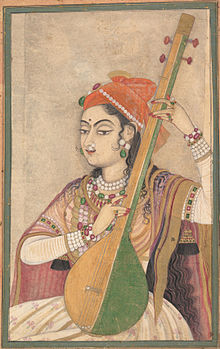Indian classical
| Music of India | |
|---|---|

A Lady Playing the Tanpura, ca. 1735 (Rajasthan)
|
|
| Genres | |
|
|
| Media and performance | |
| Music awards | |
| Music festivals | |
| Music media | |
| Nationalistic and patriotic songs | |
| National anthem | Jana Gana Mana |
| Regional music | |
|
|
Indian classical music is one of many forms of art music that have their roots in particular regional cultures. For other "classical" and art music traditions, see List of classical and art music traditions.
Indian classical music is a genre of South Asian music. It has two major traditions. The North Indian classical music tradition is called Hindustani, while the South Indian expression is called Carnatic. These traditions were not distinct till about the 16th century. There on, during the turmoils of Islamic rule period of the Indian subcontinent, the traditions separated and evolved into distinct forms. However, the two systems continue to have more common features than differences.
The roots of the classical music of India are found in the Vedic literature of Hinduism and the ancient Natyashastra, the classic Sanskrit text on performance arts by Bharata Muni. The 13th century Sanskrit text Sangita-Ratnakara of Sharngadeva is regarded as the definitive text by both the Hindustani music and the Carnatic music traditions.
The Indian classical music has two foundational elements, raga and tala. The raga forms the fabric of a melodic structure, the tala measures the time cycle. The raga gives an artist the ingredients palette to build the melody from sounds, while the tala provides him with a creative framework for rhythmic improvisation using time.Dhrupads are among the oldest classical Indian music compositions, with heroic, laudatory and spiritual themes. They are the basis for many subgenre of Indian music.
The roots of music in ancient India are found in the Vedic literature of Hinduism. The earliest Indian thought combined three arts, syllabic recital (vadya), melos (gita) and dance (nrtta). As these fields developed, sangita became a distinct genre of art, in a form equivalent to contemporary music. This likely occurred before the time of Yāska (c. 500 BCE), since he includes these terms in his nirukta studies, one of the six Vedanga of ancient Indian tradition. Some of the ancient texts of Hinduism such as the Samaveda (c. 1000 BCE) are structured entirely to melodic themes, it is sections of Rigveda set to music.
...
Wikipedia
